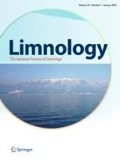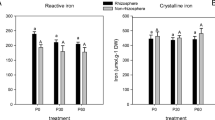Abstract
The properties of plaques were different on the root surface of Potamogeton crispus planted in sediments from two different shallow lakes. Lake Tangxunhu sediment, with low pH, contained low organic matter, whereas Lake Yuehu sediment, with high pH, had high calcium deposits mixed with high organic matter. The contents of mineral elements in sediment of Lake Tangxunhu was lower than that of Lake Yuehu, except for iron (Fe) content, but the contents of mineral elements extracted by sodium dithionite–sodium citrate–sodium bicarbonate (DCB) from root plaques were higher in Lake Tangxunhu than those in Lake Yuehu, except for Fe. These element distributions on P. crispus root plaques were characterized by scanning electron microscope combined with energy-dispersive X-ray spectrometer and were consistent with the contents of mineral elements in sediment. The root plaque of P. crispus planted in Lake Tangxunhu sediment mainly contained silicon (Si) and Fe, and the content of Si was greater than Fe, which may be contributed to the formation of poly-silicic-ferric in the natural conditions. However, the root plaque of P. crispus planted in the sediment with higher calcium content of Lake Yuehu was rich in Fe, Si, phosphorus (P), and calcium (Ca). Due to oxygen secretion by plant roots, the root plaque has more Fe3(PO4)2 and a certain amount of Ca3(PO4)2. The ratio of magnesium (Mn) to Fe extracted by DCB from root plaque in Lake Tangxunhu sediment was 0.031 and 0.010 in Lake Yuehu sediment. In Lake Tangxunhu sediment, lower content of organic matter results in weak reducibility. Enhanced oxidation ability by oxygen secretion of P. crispus root could oxidize low-valent Fe and Mn into iron–manganese oxide, which leads to formation of iron–manganese plaque on the root surface. However, this case is different in Lake Yuehu sediment, where Fe and Mn can be reduced in high organic sediment and low-valent Mn can precipitate in the sediment in which pH is >8. Thus, low-valent Fe in Lake Yuehu sediment moves to the root surface of P. crispus, where it oxidizes into Fe oxide, i.e., Fe plaque.






Similar content being viewed by others
References
Armstrong W, Justin SHF, Beckett PM, Lythe S (1991) Root adaptation to soil water logging. Aquat Bot 39:57–73
Bao SD (2000) Soil Agricultural and Chemical Analysis. China Agricultural Publishers, Beijing
Batty LC, Baker AJM, Wheeler BD, Curtis CD (2000) The effect of pH and plaque on the uptake of Cu and Mn in Phragmites australis (Cav.) Trin ex. Steudel. Ann Bot 86:647–653
Byl TD, Bailey FC, Klaine SJ (1992) Oxidation of the rhizosphere by aquatic plant roots: does acid volatile sulfide adequately predict metal availability? In: 13th Annual Meeting Society of Environmental Toxicology and Chemistry, Pensacola, USA
Cai M, Luo A, Zhang Y, Lin X, Ye J (2003) Adsorption of phosphate by iron plaque on rice roots in relation to phosphate uptake by rice. Chin J Rice Sci 17:187–190
Chabbi A (1999) Juncus bulbosus as a pioneer species in acidic lignite mining lakes: interactions, mechanism and survival strategies. New Phytol 144:133–142
Chabbi A, Hines ME, Rumpel C (2001) The role of organic carbon excretion by bulbous rush roots and its turnover and utilization by bacteria under iron plaques in extremely acid sediments. Environ Exp Bot 46:237–245
Chen CC, Dixon JB, Turner FT (1980) Iron coating on rice roots: mineralogy and quantity influencing factors. Soil Sci Soc Am J 44:635–639
Cheng H, Liu Y, Tam NFY, Wang X, Li SY, Chen GZ, Ye ZH (2010) The role of radial oxygen loss and root anatomy on zinc uptake and tolerance in mangrove seedlings. Environ Pollut 158:1189–1196
Christensen KK, Wigand C (1998) Formation of root plaques and their influence on tissue phosphorus content in Lobelia dortmanna. Aquat Bot 61:111–122
Connell EL, Colmer TD, Walker DI (1999) Radial oxygen loss from intact roots of Halophila ovalis as a function of distance behind the root tip and shoot illumination. Aquat Bot 63:219–228
Crowder A, St-Cyr L (1991) Iron oxide plaque on wetland roots. Trends Soil Sci 1:315–329
Deng D, Wu S, Wu F, Deng H, Wong M (2010) Effects of root anatomy and Fe plaque on arsenic uptake by rice seedlings grown in solution culture. Environ Pollut 158:2589–2595
Frederiksen MS, Glud RN (2006) Oxygen dynamics in the rhizosphere of Zostera marina: a two-dimensional planar optode study. Limnol Oceanogr 51:1072–1083
He C, Liu X, Zhang F (2004) Formation of iron plaque on root surface and its effect on plant nutrition and ecological environment. Chin J Appl Ecol 15:1069–1073
Hupfer M, Dollan A (2003) Immobilisation of phosphorus by iron-coated roots of submerged macrophytes. Hydrobiologia 506–509:635–640
Laskov C, Hom O, Hupfer M (2006) Environment factors regulating the radial oxygen loss from roots of Myriophyllum spicatum and Potamogeton crispus. Aquat Bot 84:333–340
Marschner P, Crowley D, Rengel Z (2011) Rhizosphere interactions between microorganisms and plants govern iron and phosphorus acquisition along the root axis—model and research methods. Soil Biol Biochem 43:883–894
Mi WJ, Zhu DW, Zhou YY, Zhou HD, Yang TW, Hamilton DP (2008) Influence of Potamogeton crispus growth on nutrients in the sediment and water of Lake Tangxunhu. Hydrobiologia 603:139–146
Otte ML, Rozema J, Koster L, Haarsma MS, Broekman RA (1989) Iron plaque on roots of Aster tripolium L.: interaction with zinc uptake. New Phytol 111:309–317
Pedersen O, Binzer T, Borum J (2004) Sulphide intrusion in eelgrass (Zostera marina L.). Plant Cell Environ 27:595–602
Perelo LW (2010) Review: in situ and bioremediation of organic pollutants in aquatic sediments. J Hazard Mater 177:81–89
Pi N, Tama NFY, Wong MH (2010) Effects of wastewater discharge on formation of Fe plaque on root surface and radial oxygen loss of mangrove roots. Environ Pollut 158:381–387
Povidisa K, Delefosse M, Holmer M (2009) The formation of iron plaques on roots and rhizomes of the seagrass Cymodocea serrulata (R. Brown) Ascherson with implications for sulphide intrusion. Aquat Bot 90:303–308
Smith BFL (1994) Characterisation of poorly ordered minerals by selective chemical methods. In: Wilson MJ (ed) Clay mineralogy: spectroscopic and chemical determinative methods. Chapman & Hall, London
Srivastava J, Gupta A, Chandra H (2008) Managing water quality with aquatic macrophytes. Rev Environ Sci Biotechnol 7:255–266
St-Cyr L, Fortin D, Campbell PGC (1993) Microscopic observations of the iron plaque of a submerged aquatic plant (Vallisneria americana Michx). Aquat Bot 46:155–167
Ström L, Owen AG, Godbold DL, Jones DL (2005) Organic acid behaviour in a calcareous soil implications for rhizosphere nutrient cycling. Soil Biol Biochem 37:2046–2054
Taggart MA, Mateo R, Charnock JM, Bahrami F, Green AJ, Meharg AA (2009) Arsenic rich iron plaque on macrophyte roots—an ecotoxicological risk? Environ Pollut 157:946–954
Taylor GJ, Crowder AA (1983) Use of the DCB technique for extraction of hydrous iron oxides from roots of wetland plants. Am J Bot 70:1254–1257
Tran T, Gray S, Naughton R, Bolto B (2006) Polysilicato-iron for improved NOM removal and membrane performance. J Membr Sci 280:560–571
Wang X, Chen X, Yang J, Wang Z, Sun G (2009) Effect of microbial mediated iron plaque reduction on arsenic mobility in paddy soil. J Environ Sci 21:1562–1568
Zeng X, Lv S, Liu W, Zhang X, Zhang F (2001) Effects of root surface iron and manganese oxide plaque on iron, manganese and phosphorus, zinc nutrition of rice. Southwest Chin J Agric Sci 14(4):34–38
Zhang X, Zhang F, Mao D (1997) Effect of root iron plaque on phosphorus uptake by rice plant. Plant Nutr Fertil Sci 3:295–299
Acknowledgments
This work was supported by the National Natural Science Foundation of China (40973056) and the Ministry of Education Doctoral Program Foundation of China (20100146110020). We thank Ms. Lihong Qin from Laboratory of Electron Microscope, Huazhong Agricultural University, for her helping unscramble SEM image and energy-dispersive X-ray spectrometery. Professor Yiyong Zhou from the Institute of Hydrobiology, Chinese Academy of Science, and Professor Huaidong Zhou from the China Institute of Water Resources and Hydropower Research are acknowledged for their kind instruction and suggestion.
Author information
Authors and Affiliations
Corresponding author
Additional information
Handling Editor: Hiroshi Hasegawa.
W. Mi and J. Cai contributed equally to this work.
Rights and permissions
About this article
Cite this article
Mi, W., Cai, J., Tuo, Y. et al. Distinguishable root plaque on root surface of Potamogeton crispus grown in two sediments with different nutrient status. Limnology 14, 1–11 (2013). https://doi.org/10.1007/s10201-012-0374-8
Received:
Accepted:
Published:
Issue Date:
DOI: https://doi.org/10.1007/s10201-012-0374-8




